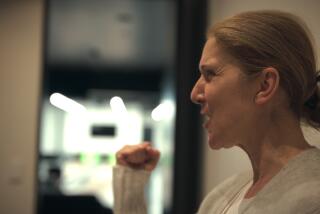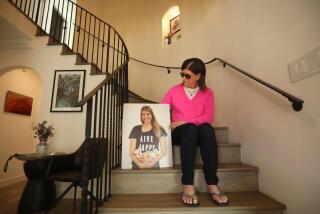A Life OUT OF THE Bubble : Teen-Ager Keeps Disease at Fringes of Her Normal Life
- Share via
LAGUNA HILLS — Alison Ashcraft has grown up under a microscope.
Like the renowned “boy in the bubble,” whose vulnerability to illnesses forced him to live in an isolated environment, she was born with severe combined immuno-deficiency disease. But unlike the child made famous by a TV movie, Alison has been able to lead a relatively normal existence because of medical advancements.
At age 17, the Laguna Hills High School junior is one of the oldest living sufferers of SCID. Her rare ailment has made her the subject of many medical journal dissertations, a CBS news special and a Pulitzer Prize-winning science story.
“Sometimes I feel like a guinea pig,” Alison said. “ ‘Let’s take some of her blood, let’s give her some shots, let’s do this, let’s do that.’ ”
Yet despite a childhood spent in doctors’ offices and hospitals, the pretty blond girl exudes cheerfulness, optimism and the determination to be a “typical teen” rather than a victim--and a bubbly girl rather than a girl in a bubble.
One in 70,000 babies is born with SCID, which is in most cases a hereditary disease carried by a recessive gene. SCID children lack both antibodies and T-cells, the white blood cells that are key weapons in the body’s ability to fight infection. Most die within the first two years from opportunistic infections or pneumocystis carini pneumonia, which also occurs with acquired immune deficiency syndrome.
There are only about 300 SCID survivors in the world. Some have reached their 20s with the help of bone marrow transplants, in which a patient’s marrow is replaced with marrow that has a family member’s antibodies and T-cells. Such transplants have been used in the treatment of SCID patients since 1968.
The lifesaving procedure, however, has not been an option for Alison. Her parents and older brother were vetoed as donors because her body would probably reject their marrow.
She does not especially mind her status as a medical phenomenon. “I think it’s really neat that they can use me to find out new things about my disease,” she said.
Alison’s ailment went undetected over her first seven years. Although she was chronically ill with recurring pneumonia, her body manufactured enough T-cells to keep her alive.
“Fortunately for Alison, she does not have a complete defect,” said her doctor, E. Richard Stiehm, chief of pediatric immunology at the UCLA School of Medicine. “She has 2% to 5% of normal immunity.”
In those first few frustrating years, Alison’s parents transported her from doctor to doctor, but no one could explain the fragile child’s constant battle with pneumonia.
“When she was 5, she would sleep 20 hours a day,” recalled her mother, Corinne Ashcraft. “One doctor was positive that she had cystic fibrosis and tested her three times for it.”
Finally, the Ashcrafts took her to an immunology clinic at UC San Francisco. “Within an hour, they identified the problem,” Ashcraft said. “It was a great relief to have a diagnosis, to have some answers as to why this child was sick all the time. You begin to take it personally, you begin to think that you’re not a good parent.”
After doctors ruled out a marrow transplant, Alison was treated with antibiotics and injections of gamma globulin. “Fill ‘er up,” she joked about the drug treatments that have become routine to her.
While her condition improved, Alison still missed two or three months of school a year. An ailment as minor as a common cold would predictably turn into pneumonia. She was out sick so often that she had to repeat the sixth grade.
Also, her sluggish thyroid gland had stunted her growth. “At 10 years old, she was the size of a 5-year-old,” Ashcraft said. Once she began taking thyroid medicine, the tiny girl grew 11 inches in 18 months.
“We were shopping for new clothes all the time,” Ashcraft said.
Alison’s next breakthrough came two years ago, when immunologist Stiehm prescribed for her a new drug, PEG--ADA, which provides a crucial enzyme lacking in some SCID patients. Since taking the drug, she has fended off pneumonia for more than a year and has missed just four days of the 11th grade.
“I have a lot more energy now,” Alison said. “Before, I didn’t know what it was like not to feel tired all the time--it was my way of life, so I just thought it was normal. Now I look back on it and think, ‘How’d I do that?’ ”
Today, Alison can enjoy her favorite pastime, tennis, for two hours at a time. She is petite rather than diminutive--5 feet tall and 90 pounds. And her sparkling blue eyes and ready giggle defy her history of maladies.
She has no memory of her monthlong stretches in bed as a child: “I remember school, I remember playing with my friends, I even remember my baby-sitters--but I don’t remember anything about being sick or going to doctors. It’s a mental block, definitely.”
Only about 15 people in the world are being treated with the drug that has turned around Alison’s life, which makes PEG--ADA extremely expensive: Alison’s treatments cost more than $300,000 a year.
Her father, Aaron Ashcraft, an executive for Nissan Motors Corp., said he worries that the drug could disappear from the market.
Alison’s fate hinges on the one small company that manufactures PEG--ADA. If the company were to discontinue the drug, her father said, “we’d be in the soup. I don’t believe that any of the major drug companies would want to pick it up, because it’s probably a losing proposition financially.”
He also is concerned that the drug will become unaffordable for Alison when she reaches 23 and no longer qualifies for Nissan’s group health insurance.
“There’s not an insurance company on Earth that would take her on,” he said.
For the present, Alison counts her blessings. “I’m lucky to have a family that has been both financially and emotionally stable enough to accept this,” she said.
Not one for self-pity, Alison has little patience for those who “dwell on small problems.”
“I admire people who make the best out of their situation,” she said. “We’re all dealt a hand of cards, and we have to live with them the best we can.”






